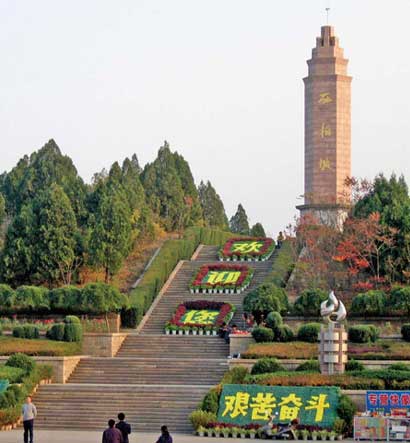Tips and Articles
Red riding journey
Updated: 2011-06-24 10:53
By Zhang Xi (China Daily European Weekly)
|
 The small village of Xibaipo, in Hebei province, was the last rural base used by the CPC and the newly named People's Liberation Army (PLA) before marching into Beijing. Zhang Runmin / for China Daily |
Red tourism has blossomed in Yan'an, a city boasting over 350 sites related to the revolution. Among these sites is a former residence of Mao, a cave dwelling in a place called Zaoyuan (Jujube Orchard). There are 20 cave dwellings, which was a kind of traditional house in northern Shaanxi that was carved out of hills, and made up of compacted earth.
Located on the Loess Plateau in northern Shaanxi province, the ancient city became the birthplace of China's revolution in October, 1935 when the Red Army established a revolutionary base after completing its epic 12,500 km journey.
It served as the military headquarters during the War of Resistance against Japanese Aggression (1937-1945) and the War of Liberation (1945-1947). The city was also the seat of the Central Committee of the CPC.
The most significant event in Yangjialing was the successful convening of the Seventh National Congress of CPC in April, 1945. Here the communist leaders commanded the war against Japanese invaders and launched the Large-Scale Production Campaign (1943-1945) to feed and cloth the people and army and maintain the war.
During this period, Mao composed and released many important articles and was interviewed by US correspondent Anna Louis Strong, who made the phrase "paper tiger" famous worldwide. The expression, zhi laohu (paper tiger), was used to describe a hollow threat, and Mao used it to describe US imperialism at that time.
"In appearance it is very powerful but in reality it is nothing to be afraid of; it is a paper tiger," Mao said. "Outwardly a tiger, it is made of paper, unable to withstand the wind and the rain. I believe that is nothing but a paper tiger."
Every day, 1000 tourists watch the re-enactment of the "Battle Defending Yan'an," a simulation of the fire fight in which Kuomintang forces assaulted the Communist base. Although the Nationalists initially took the city in March 1947, they failed to capture the CPC leadership and were ultimately defeated by the Communist forces.
Tourists are even allowed to don military uniforms and joined the show as cast members, as gunpowder smoke fills the air, and gunshots ring out.
5. Xibaipo, Hebei
This small village, 80 kilometers northwest of Shijazhuang, capital city of Hebei province, was the last rural base of CPC and PLA before they entered Beijing and took control of the country.
It was here CPC leaders commanded the last-ditch battles of Liaoxi-Shenyang, Huai'an-Haizhou and Beiping-Tianjin. After winning these three campaigns, the CPC overthrew the Kuomintang and finally won the civil war.
Decisions made by the CPC leadership during this time included launching the land reform act, issuing the renminbi ("people's currency") and shifting emphasis from rural to urban affairs.
The Xibaipo Museum reported tourism has grown 65 percent annually and the city has more than 60 hotels, which are renovated farm houses, to cater for the boom.
One of the interesting attractions, is a Leaders' Sculpture Garden. There is a collection of poems, which were written by Mao Zedong and other revolutionary leaders and these works are carved into stones in the garden.
E-paper

Franchise heat
Foreign companies see huge opportunities for business
Stitched up for success
The king's speech
Tough sail
Specials

Premier Wen's European Visit
Premier Wen visits Hungary, Britain and Germany June 24-28.

My China story
Foreign readers are invited to share your China stories.

Singing up a revolution
Welshman makes a good living with songs that recall the fervor of China's New Beginning.
